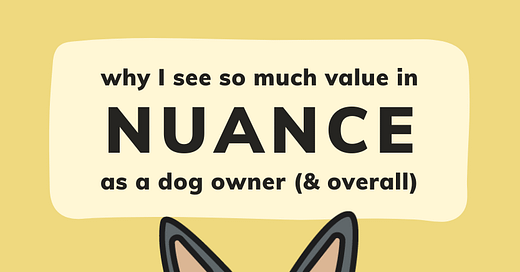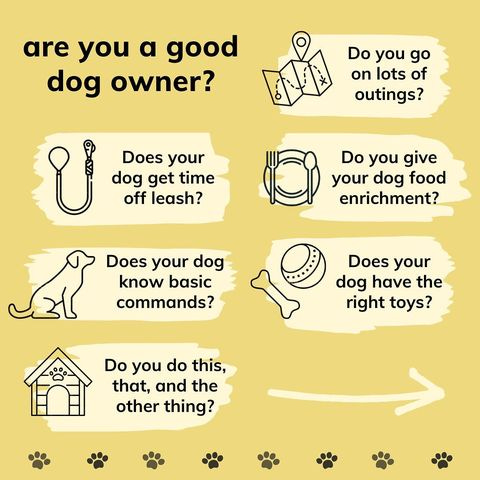Why I push for nuance in the online dog community
When you point out “gray area” on a topic (especially a controversial one that folks often get emotional about, like maybe aversive training tools or going to the dog park or if we should restrict affection) some people might think you’re making things too complicated. Encouraging overthinking. Creating confusion.
Clear communication is important!
But I see incredible value in having conversations about how generalizations often fall short, every dog and owner and situation can be different, black-and-white statements should be taken with caution… because a lack of nuance can hurt dog owners who are doing their best.
Here’s why I think middle ground is especially important in the online dog community.
First: There is absolutely a time and place for simplification!
Muddying the waters for the sake of muddying the waters doesn’t strike me as productive. There is absolutely a time and place for simplification!
I think this is particularly true in the dog training space when someone seeks out individualized professional help. Many owners are looking for straightforward steps to follow to get through a behavioral issue. Custom plans—prescribed by an expert and simplified so they’re easy for people to understand without exerting too much of their already-limited capacity—can be so valuable.
Not everyone needs all the nuance and detail and middle ground 100 percent of the time.
But sweeping generalizations can hurt dog owners who are trying their best
On the other hand, I often see complex topics simplified to wide audiences when I don’t think they should be. If we have large social media platforms, it’s important to realize how many different people might come across our content—owners with dogs in all sorts of environments, with all sorts of personal preferences, with all sorts of struggles…
There’s no way that a “one size fits all” approach is going to be the most productive thing for everybody in that group.
Controversial sound bites are great for social media engagement—but not for dogs or their people
When I first started really getting into the dog world—learning about training, moving past surface labels, realizing just how much was out there—I was overwhelmed. One thing would sound great… but then another contradictory statement would seem just as convincing… and I had no idea what to believe.
It wasn’t just the obvious debates about tools, either. It was everything. What to feed. What toys to use. What to think about x, y, and z. Even the subtle inconsistencies cast doubt into my mind. How was I supposed to know who to trust? How could I find out what was and wasn’t true if no one was pointing me to sources, or offering details, or addressing nuance in any meaningful way?
While I still have moments like that, over time I’ve been able to develop a conceptual framework that guides my decisions and helps me process new information—but it didn’t happen overnight. And it definitely didn’t happen because social media trainers shoved simple mantras down my throat with no further explanation.
No, what helped me most was hearing people explain why they felt the way they did about a certain tool or method or thought process.
Instead of just saying “this is what you should believe”, the most valuable sources made foundational information—the underlying driving forces of their claims, the overall concepts, the necessary context—accessible to me so I could make my own decisions. For my own life. With my own dog.
Further reading:
Core concepts can be applied in multiple ways
Caring about X doesn’t mean we don’t also care about Y. Valuing A doesn’t mean we don’t also appreciate B. Making different informed choices than someone else does not mean you don’t align on the important things.
Reducing our beliefs to black-and-white ideas rarely does much good… because we connect best, and most productively, when we focus on core values. Foundational pieces and overarching concepts say far more about who we are and how we live with our dogs than surface-level things like “do you ever go to the dog park?” or “does your dog ever walk in front of you on a leash?” or “do you pet your dog when they come into your personal space?” ever could.
For example, I really value clear communication and consistency and fulfillment and public respect—but I might implement those things differently than you do on the surface. We live with different dogs in different situations! If we focused only on the nitty gritty, on whether or not we executed all of the same generalized rules (make your dog wait at all thresholds, go on structured walks, etc etc etc) we might think our ownership styles were incompatible… when we’re actually aligned on the big stuff.
Further reading:
Respecting different lived experiences can help us all feel less alone
Our perceptions of the dog training and ownership world are colored by so many things: our immediate environments, the cultures around us, our ideal lifestyles, the types of dogs we own… and we carry our past experiences with us especially when they’re emotional. We can learn to be logical about them, to process them, and to move forward productively. But we can’t just shut their influence on us off.
And it’s incredibly isolating when we’re made to feel like our perceptions are inherently wrong!
Generalizations often pit us against each other in the comparison game. They make us doubt ourselves. They create a false narrative that there is one ideal.
But there isn’t. There is no one “right” way to live with a dog. There is no one “right” way to balance your daily schedule. There is no one “right” way to approach your friendships. There is no one “right” way to plan for your future. There is no one “right” way to fix a problem (or to even define what, exactly, a problem is). There is no one “right” way to make personal decisions.
There is no one “right” way to be a human.
In a world of “never do this” and “always do that” and “if you think x, y, or z you’re doing it wrong”, the gray area is more important than ever so we don’t ostracize people who could really benefit from supportive connections. We need the “sometimes” and the “it depends” and the “in this specific situation” because a good life can’t be reduced into a simple list of rules. (If it could… we wouldn’t have such a prolific field of philosophy.)
Further reading:
Dog ownership (and life!) isn’t all or nothing
While it is impossible to always capture all the nuance on a given topic even if we try—and sometimes it makes perfect sense to not try if we know our audience well—deliberate attempts to turn complex issues into reductionist sound bites for engagement never sit well with me. It might feel fun to stoke the fire of controversy. But what good does it do?
We don’t have to overcomplicate the world. But I also don’t want to oversimplify the world—especially in a public space where I have the opportunity to highlight shades of gray in emotional topics. Where a bit of middle ground might help someone feel less alone or more empowered. Where I have the chance to speak to Past Me and tell her what I wish I’d known shortly after adopting Scout.
Nuance it is here.












